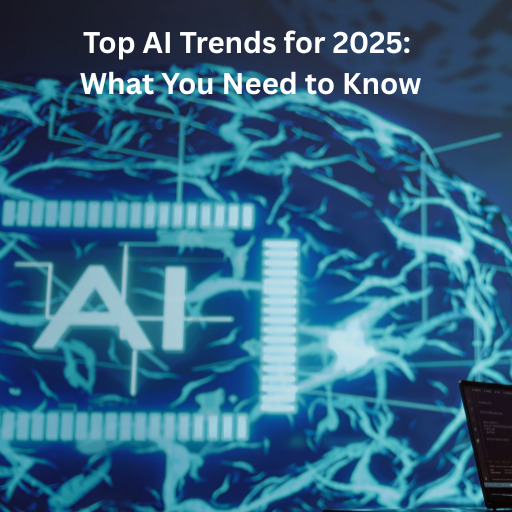What’s Changing in AI in 2025?
Artificial Intelligence has moved far beyond just answering simple questions. Today, AI is running entire business processes, creating art, helping in surgeries, and writing complex software. In 2025, AI continues to grow at lightning speed, reshaping how we work, create, and live.
This guide breaks down the most important trends of 2025, explained in simple language with real-life examples.
Agentic AI
What it means:
AI that doesn’t just respond to commands but actually plans and acts independently, almost like a human assistant.
Example:
Instead of asking ChatGPT to just “write a blog,” an Agentic AI like AutoGPT can research the topic, draft the article, edit it, and even publish it on WordPress — all by itself.
Why it matters:
This saves massive amounts of time and boosts productivity. Many companies are already experimenting with AI “employees” that run tasks around the clock.
Multimodal AI
What it means:
AI that can understand and process text, images, video, and voice — all together in one place.
Example:
You upload a photo of your fridge, and the AI suggests recipes using what it sees. Or you describe a business idea, and it generates a logo, a pitch deck, and a promotional script, all in one chat.
Popular tools include:
GPT-4o by OpenAI
Gemini by Google
Claude by Anthropic
Why it matters:
Multimodal AI makes it super easy for anyone — even people with no tech skills — to get creative work done by simply talking, typing, or showing pictures.
RAG (Retrieval-Augmented Generation)
What it means:
Instead of guessing, AI now searches real-time data or your specific documents before giving answers, so it’s more accurate and reliable.
Example:
Imagine a chatbot that doesn’t just answer from its memory but actually pulls your company’s policy documents to give precise responses.
Use cases include:
Customer support bots searching product manuals
Business tools using internal files
Legal AI that directly refers to laws and case files
Why it matters:
RAG solves a big problem called “AI hallucination” — where AI makes things up. Now it can check its sources and give fact-based answers.
Specialized AI Assistants
What it means:
Mini AI systems trained for very specific tasks like coding, therapy, tutoring, finance, or marketing.
Example:
A virtual AI math tutor for your child, or an AI financial planner that adapts to your savings goals.
Trending roles include:
AI lawyers
AI content editors
AI research assistants
Why it matters:
People will soon rely on dozens of small, expert AIs, each tailored to a specific job — making them feel more personal, helpful, and trustworthy.
AI-Powered Workflows and Automation
What it means:
Using tools like Zapier, Make.com, or Notion AI to automate repeat tasks such as sending emails, creating reports, or posting on social media.
Example:
You publish a blog post, and AI automatically writes social media captions, posts them on Instagram and LinkedIn, sends out a newsletter, and tracks how well it all performs.
Why it matters:
AI is no longer just a creative helper; it’s running real business operations. Even solo entrepreneurs can now do the work of an entire team.
Ethical AI and Regulation
What it means:
As AI becomes more powerful, there’s a global push for clear rules to ensure safety, fairness, and trust.
What’s happening:
The EU launched the world’s first big AI law, the AI Act.
The US is setting rules to label AI-generated content.
Many countries are developing ethical standards, especially for AI in hiring, healthcare, and finance.
Why it matters:
People need to trust AI. Ethical rules help reduce bias, prevent misuse, and make AI safer for everyone.
AI Plus Humans Equals Collaboration, Not Replacement
What it means:
The best results come when humans and AI work together, not against each other.
Examples:
A writer uses AI to brainstorm ideas but keeps their own style.
A teacher uses AI to explain lessons in fun new ways.
A doctor uses AI to spot patterns in medical scans but makes the final decisions.
Why it matters:
In 2025, it’s not about “AI versus humans.” It’s about “AI plus humans equals superpowers.”
Quick Summary: Top AI Trends in 2025
| Trend | What It Does | Example Tools |
|---|---|---|
| Agentic AI | Plans and acts independently | AutoGPT, ChatDev |
| Multimodal AI | Understands voice, text, images | GPT-4o, Gemini, Claude |
| RAG | Pulls data from trusted sources | ChatGPT Enterprise, Perplexity |
| Specialized AI Assistants | Focus on single tasks | Legal AI, AI tutors |
| AI-Powered Automation | Runs workflows and routine tasks | Zapier AI, Notion AI |
| Ethical AI and Governance | Adds rules and fairness | EU AI Act, OpenAI guardrails |
| Human-AI Collaboration | Boosts people instead of replacing | Co-pilot apps, AI editors |
Final Thoughts
The future of AI isn’t just about being faster or smarter. It’s about being more helpful, more accurate, and designed to work hand-in-hand with us.
Whether you’re a small business owner, a student, or simply curious, now is the perfect time to explore these tools, learn how they work, and use AI to make life simpler — not more overwhelming.
TL;DR (Too Long; Didn’t Read)
AI in 2025 is booming with trends like Agentic AI, Multimodal tools, and RAG.
Tools like GPT-4o and AutoGPT are leading the way.
Workflows are becoming automated, and specialized AI assistants are on the rise.
Ethical use and working alongside AI are more important than ever.






